Story by Troy Buzalsky
Hailing from Anchorage, Alaska, Ashbreez Boatworks, LLC could be compared metaphorically to a one-legged man in a butt-kicking contest. In other words, they are feverishly busy as they navigate and operate a boat-building, repair, and retrofit shop with—get this—only two employees: Owner and co-founder Chad Morse, and his son and co-founder Joel Morse. It’s truly amazing, the work this dynamic duo can accomplish, and that’s without compromising quality while keeping their customers satisfied from start to finish.
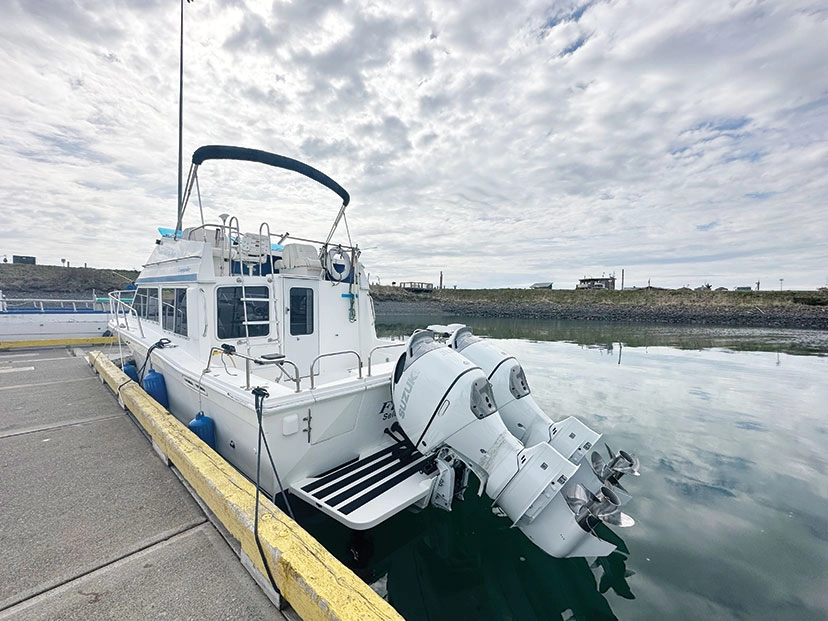
The twin Suzuki DF300B four-stroke outboards with dual contra-rotating propellers. The motors utilize a combination of the Suzuki Dual Propeller System and the Suzuki 2-Stage Gear Reduction which produce better torque and are specifically engineered for heavy applications. Additionally, the DF300B is designed to run on 87-octane fuel, which can be a big plus depending on the marina.
Ashbreez Boatworks opened its doors in 2004 and has been operating out of its current Anchorage location since 2011. Since their inception, Ashbreez has focused primarily on its saltwater audience, helping maintain the salty fleet in Prince William Sound, Cook Inlet, Kachemak Bay, and beyond. Their scope includes big jobs, small jobs, and everything in between. From bottom paint, to electrical and systems work, and from fabrication to repowers…In other words, if you have the need, chances are that Ashbreez Boatworks can be your solution.
Ashbreez Boatworks stands tall as Alaska’s sole member of the American Boat Builders and Repair Association (ABBRA) whose members are committed to high ethical practices, professionalism, quality products and workmanship, and the betterment of all through the sharing of knowledge. Ashbreez owner and co-founder Chad Morse has served as board president of ABBRA since 2019. ABBRA was established in 1943 and just celebrated its 80th year serving the marine industry. Ashbreez Boatworks is also a member of the American Boat and Yacht Council (ABYC) and completes their work in accordance with ABYC standards.
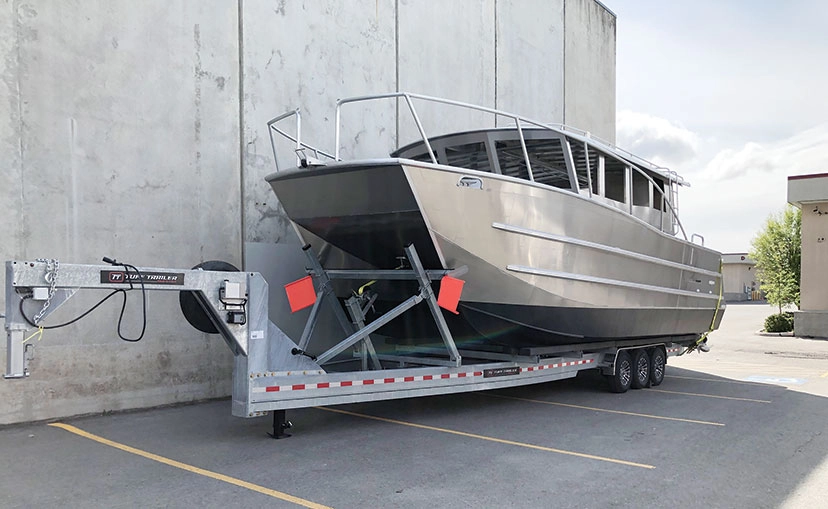
Ashbreez just took delivery of their fifth Brix hull, a 35-foot catamaran named the Resurrection 35 that features a 13-foot beam and twin Yamaha 425s. This will be the third Resurrection catamaran under the Ashbreez umbrella.
Collaboration with Brix Marine
Back in 2015, Ashbreez Boatworks and Brix Marine (formerly Armstrong) started a collaborative partnership. Brix Marine, a company that is world-renowned for their plus-sized aluminum mono and catamaran hulls, custom builds the fully welded hull to their design, but with some modifications that Ashbreez requests. Ashbreez then takes delivery of the hull and finishes the build through sea trials. To date, the Ashbreez/Brix collaborative partnership has completed four boats. At the time of this writing, Ashbreez just took delivery of their fifth Brix hull, a 35-foot catamaran called the Resurrection 35 that will feature a 13-foot beam and twin Yamaha 425s. This will be the third Resurrection catamaran under the Ashbreez umbrella. The last is featured in this column in the December 2021 Fish Alaska issue. All collaborative builds receive hull branding and VIN as an Ashbreez Boatworks’ vessel.
Seldovia, Alaska, is the biggest of the small communities across the bay from Homer and has a rich fishing history. In fact, prior to the 1964 earthquake that destroyed its boardwalk and much of the town, Seldovia was actually bigger than Homer, and some would say Seldovia is actually the Halibut Capital of the World. Today, Seldovia is a thriving oceanfront hamlet that is not only a perfect fishing getaway, but also home to the M/V Fidelia, a 2000 Commander 30, the most recent project commissioned to Ashbreez Boatworks.
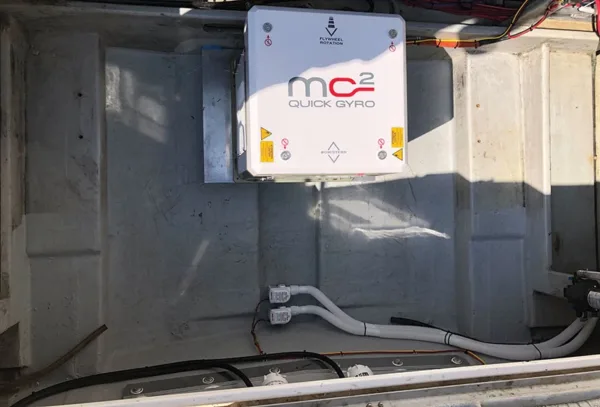
The MC² Quick Gyro is mounted as forward as possible and sits in the former engine bay.
Latest project
Commander Yachts is the original builder of this 2000-era 30-foot Commander which originally came equipped with twin 260 HP Volvo diesels with sterndrives. Twenty-three years later with thousands of hours under its belt, it was time for a repower and refit. Ashbreez Boatworks, having done numerous conversions, was chosen for the project. The scope of the work commissioned included removing the original twin diesel motors and sterndrives and replacing them with twin 300 HP Suzuki outboards, reconfiguring the former engine bay to accept an on-board MC² Quick Gyroscope, adding a Dometic Seastar Optimus 360 joystick steering system, adding an EZ-6 Rebel Anchor Puller, cleaning up legacy wiring to ABYC standards, and new bottom paint.
“Repower and refits continue to be a major theme across the United States and globally,” explains Chad Morse. “If you love your current boat and its hull is sound, and you really don’t want to give it up, but would like to improve it, consider full or partial refits, from motors to hull repaints, to deck reconditioning, to refurbishment/remodeling of the cabin interior. It is all possible, whether it is a 22-footer or a yacht…and it’s a big piece of the work we do at Ashbreez.”
In a simplistic world, a marine repower can be as easy as removing old motors and installing new motors. In the case of the Commander 30, this was not the case, as the boat would be transitioning from twin inboards to twin outboards.
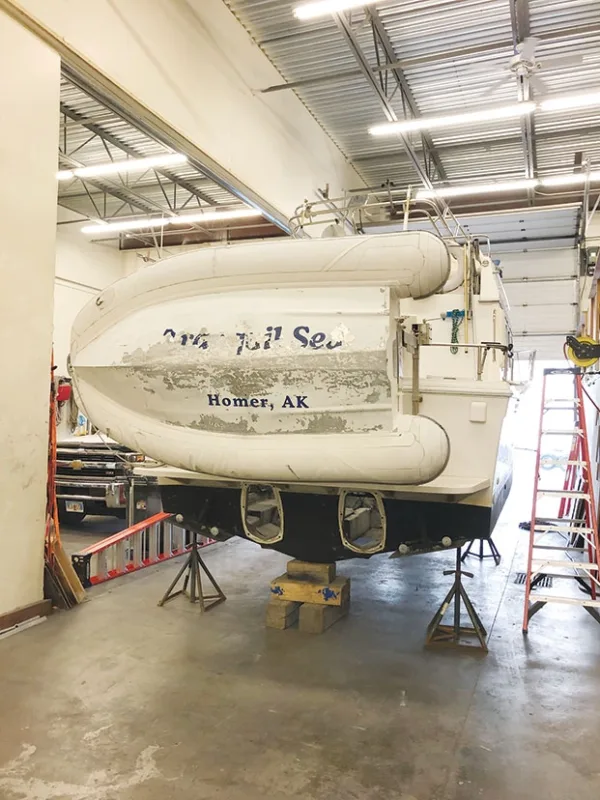
Formerly the Tranquil Sea, the 30-foot Commander sits on stands in the Ashbreez shop. Twin Volvo diesels have been removed, and the work is just getting started.
Not a cut-and-paste project
The Commander 30 was engineered by a naval architect and its weight and ballast were carefully calculated when originally commissioned. Now remove two heavy diesel inboards with their respective outdrives that weigh roughly 1,000 pounds each, and hang twin 300 HP outboards that each weigh approximately 700 pounds aft of the boat’s transom, and you have clearly changed the factory engineered nautical dynamics.
Add to the repower project the twin transom holes that remain after the outdrives are removed, and the fact that the boat’s transom now needs an offshore bracket capable of handling the weight and torque of the new high-thrust motors while pushing a stout 30-foot fiberglass hull through the open ocean, and you can see this is not a cut-and-paste project and needs to be tackled by an expert in the industry.
Ashbreez Co-founder and captain, Joel Morse was raised on the water and has worked on commercial fishing vessels as well as serving as a charter captain over the years. Joel’s boat-building and repair experience started with an apprenticeship with Devlin Designing Boat Builders. He has just short of two decades of experience working with fiberglass, composite wood, and aluminum boats. His experience also includes rigging, interior construction, renovations, modifications, special systems, repaints, and gel coating. In other words, the Commander 30 is in good and capable hands.
Transom inspection
With the engines and outdrives removed, the transom inspection was first on the list. Chad notes, “Many glass boats have a wet transom core to deal with, but the Commander’s transom was in great shape.” The sterndrive keyholes were plugged, faired, and reinforced, and the outer skin barrier coated and then bottom coated, making the patchwork look factory original. Inside, the engine bay required some refitting, as this would be the new location for the MC² Quick Stabilizing Gyroscope.
Rather than reinvent the wheel, Ashbreez utilizes the PDR Marine Fabrication outboard transom bracket. PDR has been making marine transom brackets since 2000 and could be considered the gold standard for repower and refits in the fiberglass boat arena. The PDR bracket can be ordered for single or twin configurations, as well as for catamarans. The offshore-style bracket is designed for today’s four-stroke motors and provides a smooth ride with greatly reduced vibration and noise. The brackets are designed with a sealed, buoyant chamber that provides an angled planing surface while adding tail floatation and support. Brackets can be custom ordered and can incorporate an auxiliary motor on the port or starboard side.
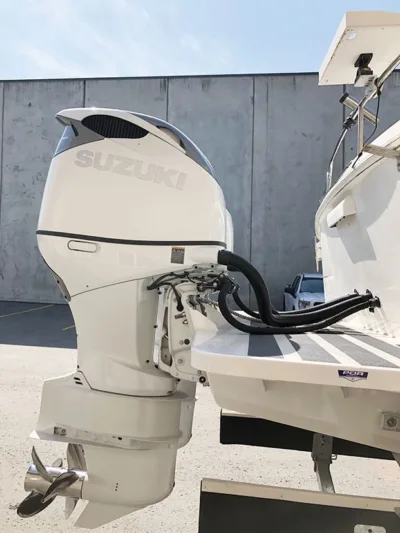
The PDR Offshore Bracket is mounted, and the twin 300 Suzukis are installed, looking factory original, yet it’s a huge upgrade.
Gyroscope installation
With the original engines removed, the engine bay became the perfect place to locate the boat’s new MC² Quick Gyro Stabilizer, which is designed to reduce boat roll by up to 95%, and work exceptionally well at low speeds and on anchor. Gyroscopes are a hot new trend in refitting, and the MC² Quick Gyro X7 is a first for Ashbreez Boatworks. They are the sole dealer, installer, and service provider in Alaska. “You don’t just buy and install a gyroscope,” explains Chad. “This last December, Joel was in Baltimore training with Quick USA on the MC² Stabilizing Gyro and received hands-on-training, and has knowledge base necessary for installation and servicing the Quick Gyro.”
The MC² Quick Gyro is designed for maximum safety and greater on-the-water comfort, especially in sporty seas. The MC² uses dedicated lithium-phosphorous batteries and can be managed through its remote touch-panel 5-inch graphic display that was installed in the overhead dash of the Commander 30. The touch display monitors the precision release, RPM, and width of the angle of inclination. It also provides maintenance reminders and alarms in the event of failure. There’s also an MC² Mobil App for smartphone and tablet use.
EZ Anchor Puller
The Commander 30 was equipped with a standard Lewmar Windlass anchor system that is used extensively in the industry, but from my experience, there are improvement opportunities. Ever since I pushed the “drop” button on an EZ Anchor Puller Rebel series and witnessed the stainless-steel drum anchor-winch freefall without backlash, I knew it was a winner. I fully understand why adding the system to a refit is one of the no-brainer decisions, especially for deep-water anchoring or when fast anchoring deployment is critical. The Commander 30’s front bow serves as an excellent location for the top-mount EZ Anchor Puller and provides direct visibility to the entire anchor system when anchoring. There’s no doubt the EZ Anchor Puller will make sitting on the hook an effortless endeavor.
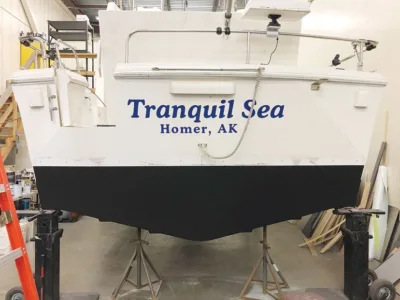
The sterndrive keyholes were plugged, faired, and reinforced, and the outer skin barrier-coated and then bottom-coated, making the patchwork look factory original.
Swapped out power train
The decision for the boat owner to swap out the original power train was largely driven by the fact that the system wasn’t performing to its potential and was very unreliable—something you don’t want when venturing offshore. It was time for the motors to be replaced, rebuilt, or converted. The Commander 30 was repowered with twin Suzuki DF300B four-stroke outboards with dual contra-rotating propellers. The motors utilize a combination of the Suzuki Dual Propeller System and the Suzuki 2-Stage Gear Reduction which produce better torque and are specifically engineered for heavy applications. Additionally, the DF300B is designed to run on 87-octane fuel, which can be a big plus depending on the marina.
During the initial sea trials, Joel and the owner put the boat through the typical break-in tests. Cruising at 29 knots (33.3 MPH) the boat ran at 4,250 RPMs and 1.4 miles per gallon. “All I can say is the owner was all smiles,” exclaimed Joel.
During the Ashbreez refit, the Commander 30 also received the Optimus Electronic Power Steering (EPS) and the Optimus 360 Joystick Control. This combination brings a whole new level of precision to your boat’s steering. The intuitive, retrofittable joystick allows you to move not only forward and back, but also sideways. With additional features including a sensitive touch function and Take Command mode, the Optimus 360 lets you direct and rotate the boat with confidence and control. Since the boat is equipped with dual stations, both inside the cabin and on the flybridge, joysticks and dual throttles were located in both locations.
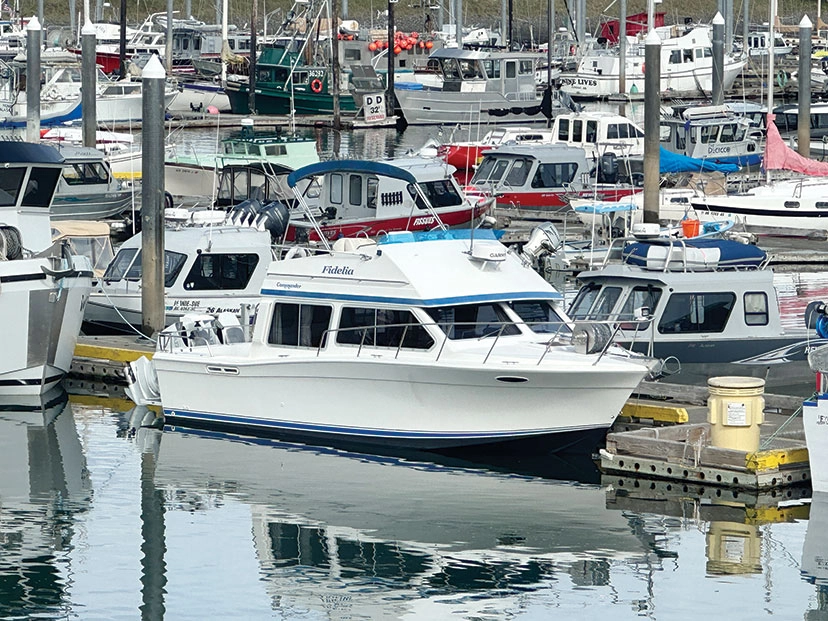
Mission complete, the 30-foot Commander M/V Fidelia with its extensive refit sits in the harbor, ready to show off its new capabilities. Note the EZ Anchor Puller mounted on the bow.
Mission accomplished
When working on a legacy vessel, sometimes you don’t know what you’re getting into until you get into it. In the case of the Commander 30, the boat’s wiring was a tangled mess and a potential hazard. “We removed every bit of exposed wire, and rewired the entire boat,” shared Joel. The boat’s wiring is now not only presentable but meets ABYC standards.
The final project for the refit was to rename the vessel. Its original name was Tranquil Sea – Homer AK. The new name gracing the transom and pilothouse is Fidelia – Seldovia AK. Coincidently, Fidelia in Latin means loyalty, a great name for a boat if you ask me.
It only takes one look at the Commander 30 M/V Fidelia to realize that Chad was spot-on when he said, “If you love your current boat and its hull is sound, and you really, in your heart-of-hearts don’t want to give it up, but would like to improve it, consider full or partial refits.” Well, here it is, the newly improved M/V Fidelia. As is always the case with Ashbreez Boatworks, they have another friend for life. For more information on Ashbreez Boatworks go to ashbreezboatworks.com, and to follow their work visit their Facebook page.
Troy Buzalsky is the Boats columnist for Fish Alaska magazine, and when not writing about boats he can likely be found chasing fish in the Pacific Northwest and the 49th state and writing about those adventures. Troy can be reached at troybuz@comcast.net.


